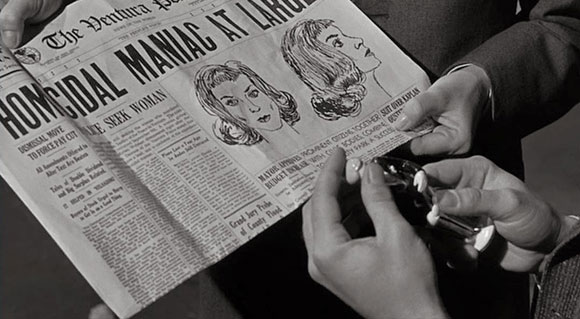There’s something ineffably “off” about this woman who is on some inscrutable mission. Her rigid blonde coiffure is obviously a wig, and she seems hesitant to remove her long white gloves. After purchasing a wedding ring, she checks into a hotel using the alias Miriam Webster, then persuades the sexy bellboy (Richard Rust) into marrying her with a $2000 cash bribe on the understanding the wedding will be immediately annulled afterwards. Once the wedding ceremony is hastily completed later that night, to everyone’s shock “Miriam” abruptly pulls out a knife, fatally stabs the justice of the peace and - amidst the screaming and bloodshed - flees the scene. The next time we see her, Miriam is now identified as “Emily” and she’s menacing Helga, a mute, disabled elderly woman confined to a wheelchair. (The scenes of a vulnerable woman in a wheelchair being terrorized anticipate What Ever Happened to Baby Jane? (1962). As Helga, Russian actress Euginie Leontovich manages to overact wildly while never uttering a single line of dialogue).
What, you may ask, the hell is going on and who are these people? The real Miriam Webster, it transpires, is a virtuous brunette florist (Patricia Breslin), engaged to dreamboat local pharmacist Karl Anderson (Glenn Corbett). The children in the introductory flashback represented Miriam and her half-brother Warren. Warren Webster (Jean Arless) is due to inherit the $10 million family fortune following his upcoming twenty first birthday. (Miriam and Warren shared the same father, who is now dead. Weirdly, the will stipulated only the male heir would inherit anything. Goody two-shoes Miriam is remarkably unperturbed about this). Why their childhood nanny Helga – now an invalid following a stroke – still lives with Warren is never adequately explained, but we do know that William and Helga only recently returned from a long sojourn in Denmark. In fact, they brought back the murderous nurse and housekeeper Emily from Denmark. Just how does she figure in all this?
Decapitated heads! A newspaper headline exclaiming “Homicidal Maniac at Large!” Lingering close-ups of knives! Dark family secrets! Wigs! Homicidal has it all! John Waters has been voluble in his praise for William Castle, citing him as a primary influence and even declaring, “In fact, I wish I were William Castle.” (In 2017 Waters portrayed Castle in the TV anthology series Feud: Bette and Joan). Castle is probably best-remembered for hits like House on Haunted Hill (1959) or 13 Ghosts (1960), but I’d argue Homicidal is his meisterwerk, alongside Strait-Jacket (1964) starring Joan Crawford as an ax murderess. Castle was also, of course, the king of the attention-grabbing publicity stunt. The gimmick here is the “fright break”. (As Homicidal builds to its climax, the action pauses for 45-seconds and a clock ticks down as Castle himself announces that if you don’t want to be “frightened to death”, you are eligible for a full refund).
Seen today, Homicidal is most interesting as an exemplar of “transploitation” or “gender reveal horror”. Other examples in this subgenre might include Psycho (1960), The Name of the Game is Kill (1968), Miss Leslie’s Dolls (1972) or Sleepaway Camp (1983). One clue is the repeated references to Denmark: transgender pioneer Christine Jorgensen underwent her reassignment surgery in Copenhagen in 1952. (The Jorgensen story also inspired Ed Wood Jr to make Glen or Glenda? (1953)). You’ll immediately notice that one character has markedly androgynous characteristics. And that no one questions that two certain characters never once appear in the same room at the same time. (But then, no one ever thinks to hand Helga a pen and paper – she could instantly explain everything!). Homicidal hits a crazed pinnacle when Emily runs amok in Miriam’s florist shop, vindictively destroying the floral arrangements. She focuses her rage on the wedding displays, snapping-off the heads of the little groom figurines. Take that, heteronormativity!
The cast of Homicidal is noteworthy for the presence of two exceptional paragons of male pulchritude. Early in his career, bodybuilder Glenn Corbett posed for Athletic Model Guild wearing nothing but a posing pouch, a sheen of baby oil and a smile. (Do a Google image search. You’ll thank me!). As the bellhop, Richard Rust possesses the hooded eyes, snarling voice, cruel smirking mouth and greased-back hair of the perfect delinquent thug. But ultimately, it’s the menacing and strange portrayal of Emily by actress Joan Marshall who makes the greatest impression. (Fun trivia: in 1964, Marshall would play Lily Munster (then called Phoebe Munster) in the unaired colour pilot episode of The Munsters. She would subsequently be replaced by Yvonne DeCarlo).
/ Glenn Corbett in his beefcake modelling days, posing for Bob Mizer of Athletic Model Guild /
Homicidal is viewable on Amazon Prime.
Further reading
Read a perceptive and in-depth analysis of Homicidal on the essential Dreams are What Le Cinema is for blog here.


































